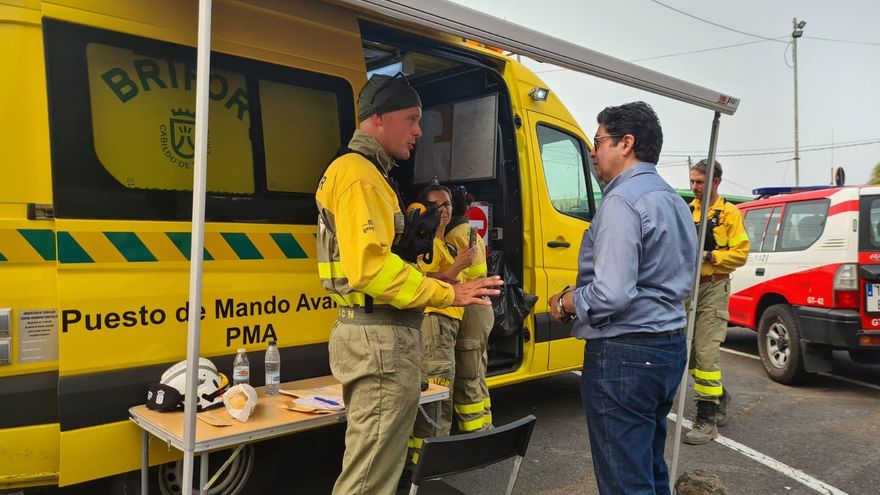
More than 300 people participate in the operative against fires forestry in Tenerife which includes as a novelty this year the acquisition of eleven new pumpers forestry. Five of them with capacity for between 3,000 and 4,500 liters and another five light ones for 500 liters. Specifically, there are 327 people who already work in the device deployed by the Cabildo. Its objective is to prevent that they do not originate or spread if fires occur in the 43 protected areas on the island that occupy 48.6% of the 2,034 square kilometers of surface. The insular president, Pedro Martín, recalls that “the operators of the Council of Tenerife They are deployed throughout the year to carry out management, prevention, control and extinction tasks. In addition to the usual staff of 163 troops, since last April, the 122 reinforcement workers who will be deployed until mid-December, as well as the 42 troops from the Parque Nacional del Teide. Martín stresses that “now preventive treatments are being developed and they act on forest fuel.” With regard to land operations, the novelty this year is the incorporation of six new forest fire trucks with a capacity of between 3,000 and 4,500 liters and five light ones of up to 500 liters.
The deployment
This year’s land operation will be made up of three 9,000-litre pumpers, 14 forestry pumps with a capacity of between 3,500 and 5,000 litres, two 1,800-litre medium-sized pumpers, 30 500-litre light pumpers, an Advanced Command Post vehicle and 29 all-terrain transport vehicles. At the aerial level, there are two helicopters based at the Tenerife Sur airport and three drones with a thermographic and visual camera to take images and videos. The Minister of Natural Environment and Security Management, Isabel García, assures that “all these resources are essential for the response to a fire to be as fast as possible, but we must also call for responsibility to all the people who live in this Island to avoid the scourge of forest fires”. In this sense, the island manager anticipates that to improve the capabilities of the operation “the usual training will be carried out throughout the entire campaign, where extinguishing techniques in large fires and actions in interface fires will be addressed, especially significant areas of intervention here.
Support media
To the own means of the insular Corporation must be added the availability, during the risk period, of others from the Government of the Canary Islands. Specifically, five GES multifunction helicopters and rapid intervention teams (EIRIF) located on each of the smaller islands. The Ministry of Agriculture, Fisheries and Food also offers the availability of two 1,600-liter medium helicopters to replace the Kamov K-32 helicopter; the Puntagorda Brif, in La Palma; and a cargo plane on the ground (3,200 liter Air Tractor) at La Gomera airport. Likewise, the Military Emergency Unit (UME) collaborates in case of need with troops according to demand. There are two detachments, one of them in Tenerife (Los Rodeos Barracks) and the other in Gran Canaria (Gando Base).
reforestation
On the other hand, more than a hundred people have been working since the beginning of this year to restore the mountains affected by the fire last summer in the North of the Island. President of the Council of Tenerife, Pedro Martín, points out that “the works will continue until the middle of next year and throughout 2023 they will improve an entire space that at the time burned, 2,700 hectares, for a repopulated area with new vitality.” The recovery plan contemplates actions in the channels, trails, tracks and reforestation in the municipalities of Los Realejos, the most affected, San Juan de la Rambla, La Guancha and Icod de los Vinos. The insular investment in these works is more than 4,441,000 euros. They began with urgent tasks for the recovery of the slopes and actions in the channels. Regarding reforestation, the technicians explain that due to the inclination of the terrain on the slope of Tigaiga, planting species is impossible to do manually, so drones will be used to spread seeds of species typical of Monteverde such as torvisco (daphne gnidium), malfured (Hypericum grandifolium), malpica, (Carlina xeratheroides), algaritofe (Cedronella canariensis), granadillo, (Hypericum canariense), cross, (Hypericum reflexum), cruet (rume), pennyroyal (Bystropogon canariensis x lunaria), chajorra (sideritis canariensis) and broom (Chamaecytisus proliferus).
track recovery
In the perimeter of the fire, the Cabildo works in the recovery of more than 40 kilometers of three forest tracks which, due to the passage of firefighting vehicles, were affected. For this, a machine called stone crusher which takes advantage of the track’s own bearing material, crushes stones up to 30 centimeters in diameter and reuses them to generate a new pavement.
E Other actions. The rest of the actions of this intervention contemplate the realization of orthophotos and digital models of the terrain of the burned area; renewal and replacement of signage; ecosystem monitoring; installation of drinkers and houses for birds and bats; repairs to hydraulic infrastructures or the construction of fences to exclude herbivores in the Teide National Park.















